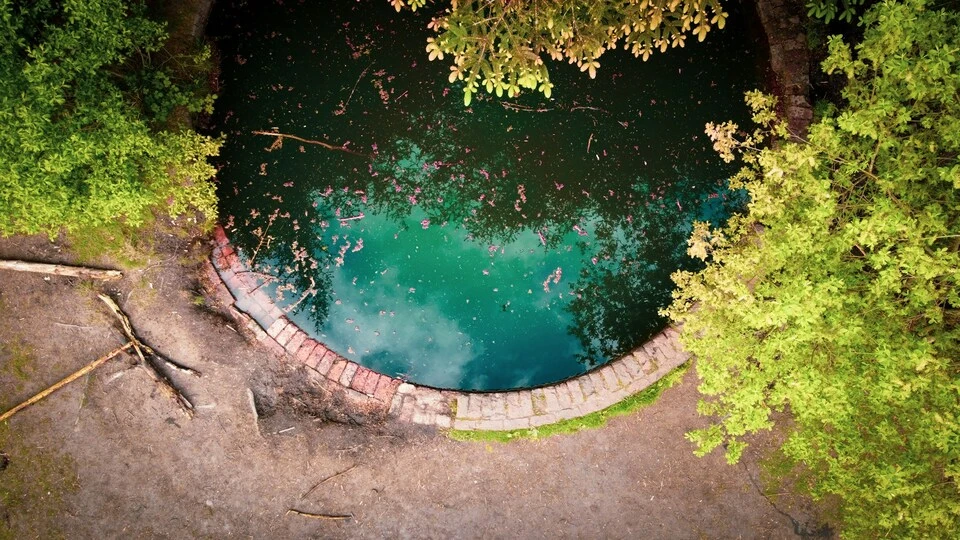Opt for a Chemical Free Pool and Forget about Plastic (in) Swimming Pools!

The traditional swimming pool is a symbol of leisure and luxury, but it’s also become a source of environmental concern. Homeowners are becoming more conscious of their ecological footprint, and the demand for sustainable alternatives to conventional swimming pools has surged.
Chemical free pools aren’t just a trend, but a fundamental shift in how we approach these classic home additions. These innovative plastic-free solutions offer the perfect balance between enjoying a refreshing swim and maintaining environmental responsibility, proving that luxury and sustainability can coexist harmoniously both in our homes, and in our backyards.
Issues With Plastic Swimming Pools and Their Chemicals
When we think of plastic pools, many of us immediately think of the paddling pools of our youth. But plastic pools come in a variety of forms, ranging from basic inflatable pools to foldable metal-framed plastic pools and top-end vinyl pools, which are higher-quality above-ground pools made with a vinyl liner.
Plastic pools typically have a lifespan of between three and five years, contributing to considerable waste when they’re disposed of. What’s more, as a toxic material, the plastic they’re made from leeches microplastics into the water and then into the environment.
Since the exposed walls lose heat faster than in-ground alternatives, they’re far from perfect when it comes to energy efficiency. What’s more, because they’re often temporary structures, the annual cycle of assembly and disassembly creates wear and tear, resulting in more plastic particles being released.
While the lower cost of plastic pools might seem attractive, the cumulative costs of replacements and maintenance can exceed more permanent solutions over time. Chemical-free pool alternatives like natural swimming pools provide a solution that not only avoids contributing to the plastic problem, but also benefits the environment.
Plastic and Chlorine
Chlorine is routinely added to pools, hot tubs, and spa water as a disinfectant to kill off bacteria, viruses and harmful microorganisms which minimizes the spread of disease. In outdoor pools, it can also prevent algae growth and break down dirt and debris to keep the pool water safe. However, while it’s safe for the skin (when added in the right ratios), it’s harmful to swallow chlorinated water and it poses a threat to the environment.
When chlorine interacts with plastic and PVC linings, it creates a troubling scenario. The chemicals accelerate the degradation process and release harmful chemicals into the water, which not only compromises the structural integrity of the liner and the pool itself but creates a potentially harmful environment for swimmers and the surrounding landscape.
The environmental impact of chlorine and plastic extends far beyond the immediate pool area. These chemicals eventually make their way into groundwater systems, and in warmer climates or pools with higher concentrations, the degradation process is even faster, making this issue particularly prevalent during peak swimming seasons.
Microplastics in Swimming Pools
While swimming pools provide the ideal space for recreation, relaxation, and exercise, they can be unexpected contributors to microplastic pollution in ways we might not think about.
Pool accessories, for example, like pool noodles and floatation devices, can shed microscopic plastic particles into the water.
Pool covers are another significant source of microplastic contamination. When exposed to intense sunlight and varying weather conditions, plastic covers become brittle and break into smaller particles that enter the water. Even high-quality covers eventually deteriorate, contributing further to the microplastic load.
We rarely consider how what we wear in the pool can impact plastic pollution, yet swimsuits are almost always made from materials that shed microplastics. Swimwear needs to wick moisture away from the outside but stretch and fit the body closely, and enable easy movement through the water. For these reasons, synthetic fabrics like nylon and spandex are typically used.
However, by definition of being synthetic, these materials are not able to biodegrade or decompose and they’re made from plastics which release microparticles into our waterways, both when we wash them and when we swim in them. Not only have scientists found microplastics in wild fish and the wider ecosystem, but there’s now evidence that these particles have entered the food chain and have been found in humans too.
Traditional pool filtration systems can capture some larger particles shed from swimwear and pool toys, but most microplastics are small enough to pass through standard filters, accumulating in the pool water and making their way into the environment during backwashing and water replacement.
Related: Home Comfort Systems aka HVAC: The Importance Of Air Purification
What Are Chemical Free Pools?
Chemical free pools, also known as natural swimming pools or swimming ponds, use a combination of plants and sand filters to clean the water without the need for chlorine and other chemicals. Developed in the 1980s in Austria and Germany, they’ve become popular worldwide for their ability to strike the perfect balance between beauty and function.
How Do Chemical Free Pools Work?
Natural pools are essentially self-contained ecosystems—carefully selected plants and beneficial bacteria work together to keep the water clean. These pools mimic nature’s own water purification processes, creating a system that’s not only beautiful but self-cleaning. Swimming in a chemical free pool is like wild swimming in a lake — environmentally-friendly, free from chlorine, and naturally beautiful.
The success of a natural swimming pool lies in its thoughtful design integration. The core component of a chemical free pool is the regeneration zone, which usually takes up around half of the pool’s total area. This houses carefully selected aquatic plants that act as natural filters, removing impurities and maintaining water clarity. The swimming area is separated from this zone, but it remains part of the same water system.
Deep zones keep the temperature stable, while shallow areas support a diverse range of plant life. Natural filtration systems, including carefully layered gravel and specialized biofilters, work in tandem with the flora to maintain water quality. Submerged pumps and discrete hydraulic systems are also added to circulate the water without the need for a plant room, so they’re the ideal solution for homeowners with less outdoor space too.
Beneficial to the Environment
Not only do these pools eliminate the need for harsh chemicals and avoid plastic pollution, which significantly reduces both environmental impact and ongoing maintenance costs, but they also create valuable habitats for local wildlife, enhancing biodiversity in your backyard.
The self-sustaining nature of chemical free pools means less time spent on maintenance and more time enjoying the water. They serve as year-round landscape features, offering visual interest even during non-swimming seasons through their evolving ecosystem.
Related: 11 Tips for Plastic Free Gardening Made Easy
Conclusion: A Pool Without Chemicals? Switching to a Natural Pool is Possible!
The shift from chemical to biological water treatment requires a bit of patience. After removing all traces of chlorine and other pool chemicals, beneficial bacteria and microorganisms need time to establish themselves, which can take anywhere from a few weeks to several months. The plants you choose play a crucial role in successful filtration, requiring a mix of oxygenating underwater plants, floating plants for shade and nutrient absorption, marginal plants around the edges, and deep-rooted plants that help maintain water quality.
As awareness grows about the environmental impact of traditional pools, natural swimming pools offer a viable, attractive alternative that enhances property value while providing a unique swimming experience. Choosing this sustainable option enables homeowners to balance a demand for environmental stewardship while still getting to enjoy the luxury of a private swimming oasis.




